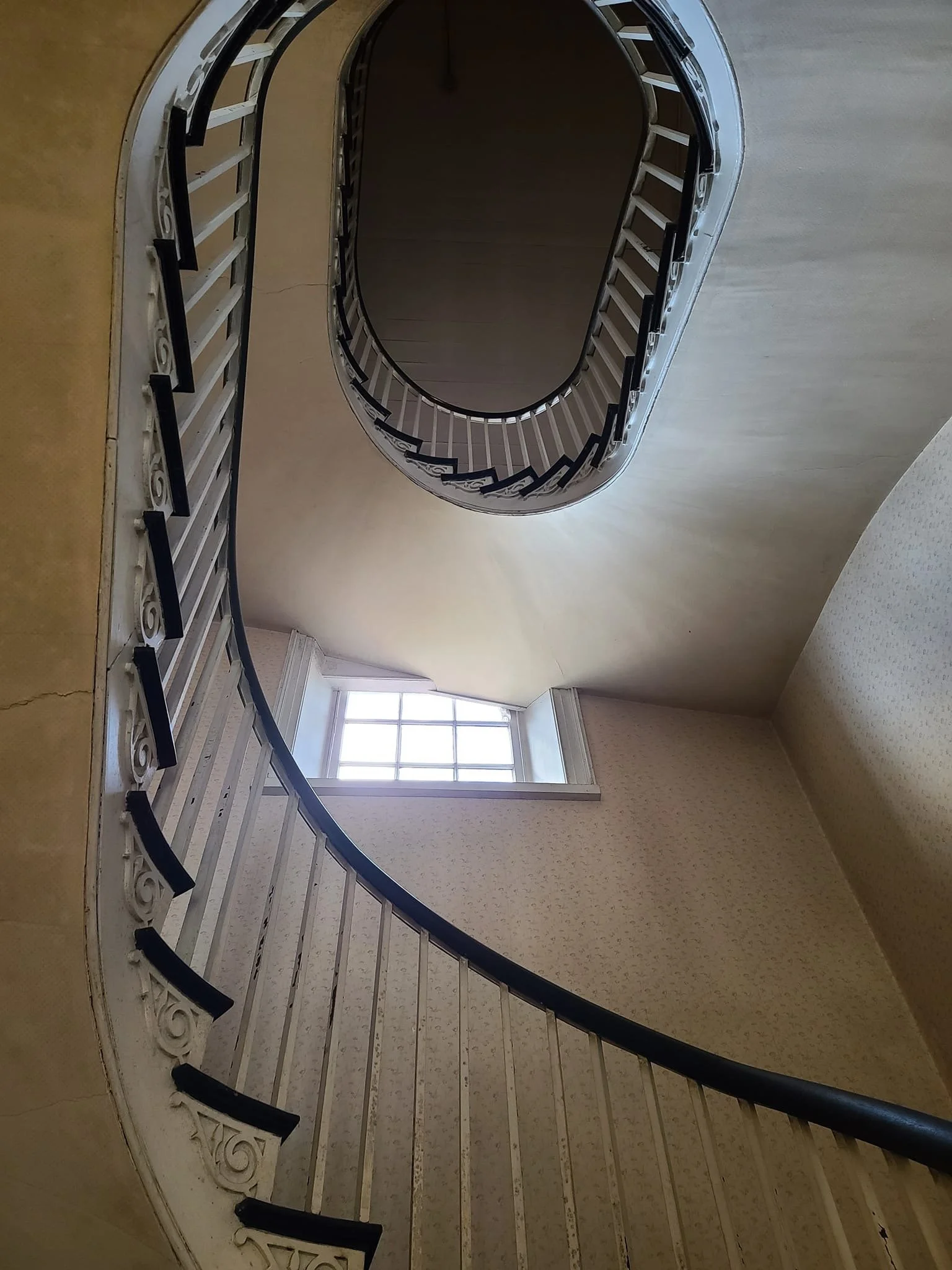

Historic Cedar Grove
A magnificent example of Greek Revival architecture built between 1831 and 1833
Front view of historic Cedar Grove, photo courtesy of HEARTS.
Cedar Grove, also known as the James Galbraith Torrance House, is the 5,000 square-foot Greek Revival home of the “Cotton King of Mecklenburg,” James G. Torrance and his third and final wife Margaret Allison of Iredell County. James was the only biological son of Scots-Irish immigrant, Hugh Torance, who purchase the land on which Cedar Grove sits from John McDowell in 1779.
In 1831, after the passing of both his father and mother, Hugh Torance and Isabella Galbraith Falls Torance, James tore down the original one-story house his father built for Isabella and constructed the red brick home known as Cedar Grove that still stands there today. The smaller family home in which James and Margaret lived during the construction of Cedar Grove is miraculously still standing and is located next door. The historic Hugh Torance House and Store was his father’s first residence in Mecklenburg County and is known as the oldest standing store in North Carolina.
Cedar Grove’s name came from the many cedar trees Hugh planted on the property. The house features a central stairway that spirals up three floors leading to spacious main hallways, 13-foot high ceilings and large fireplace mantles. In James keep, he expanded his fathers’ cotton plantation to more than 3,000 acres and became one of the wealthiest men in Mecklenburg County - on par with the Davidsons, Lattas, and Alexanders of the time. The property included numerous outbuildings, a grist mill, a molasses mill, a bank barn, a granary and ice house, many enslaved quarters, and more that is still being discovered.
The master builders and carpenters for the house were David Hampton and Jacob Shuman. The staircase is said to show the influence of the Stirewalt style - a master builder in Rowan County, with whom Hampton and Shuman may have apprenticed. Most of the construction materials were gathered and processed on-site while most of the hardware and the window glass came from Philadelphia as well as most of the original furniture. Through the research of Dick Banks, we know the home was constructed by these master craftsmen and also including enslaved people. Record books show that brick production and kilns on nearby creek banks directed by master mason V. Rivafavoli made 12,000 bricks between October 3, 1830 and May 5, 1831. In total, Rivafavoli and his crew made over 20,000 bricks. Additionally, lumber for the home was milled at Torrance Mill, which served as a grain and a sawmill for the 19th century plantation of Mecklenburg County.
James died in 1847 and the property was passed to one of his sons, Richard Torrance, a Civil War veteran who lost a leg during a battle in Nashville, TN. The historic prosthetics of Richard Torrance are on display at Cedar Grove and when thumps are heard in the night at the property, it’s usually attributed to the spirit of Richard Torrance’s infamous after-hours wandering.
When Richard “Captain Dick” Torrance passed away in 1927, numbered slips were drawn from a hat to determine how the plantation would be split between his 11 children. After the family left the property in the early 1900s and moved into Charlotte proper, Cedar Grove was occupied by tenant farmers until descendant Dick Banks and his wife Belle moved back into Cedar Grove in 1948 and upgraded the home to match styles popular in the 1950’s. You can read all about their upgrades made to Cedar Grove in Bell Bank’s oral history recorded as part of a UNCC program to document legacy interviews on the Charlotte region.
In 1974, Cedar Grove was one of the first Mecklenburg County properties recognized as a historic landmark and the family’s diligently recorded papers, long stored in the attic, are now one of the largest collections of a family’s history in North Carolina preserved at the UNC Charlotte archives.
In 2022, Cedar Grove began its current chapter through the Torrance Preserve, a private partnership with the mission to preserve and share Cedar Grove and the surrounding historic properties.
The research, connections, and desire to share the incredible history of this site from prehistoric times to the 21st century was the spark that launched the HEARTS mission. Thousands of Torance, Torrance, and Torrence descendants, along with many other early pioneer families have connections to this site, as do the descendants of those once enslaved in this area. Through the research efforts of the HEARTS Reunion Project, the names of 143 people enslaved at Cedar Grove are now on permenant display at Cedar Grove as well as being included in the national 10 Million Names Project.
In 2022, Dan Morrill wrote this updated essay on Cedar Grove, and the Cedar Grove Landmark Report offers additional information about the history of this site. Please note that an addendum on slavery at Cedar Grove appears first, followed by the original historic landmark report.
Although Cedar Grove is not open to the public, the Torrance Preserve opens the doors of Cedar Grove for HEARTS Happenings and in support of its’ sister property, the historic Hugh Torance House and Store, and as well as for private event rentals.
A look up the staircase at Cedar Grove, photo courtesy of HEARTS.
Photo of the backside of historic Cedar Grove, which was originally the front of the 1831 plantation home.
The Enslaved at Cedar Grove
The names of the enslaved who lived at Cedar Grove, photo courtesy of HEARTS.
A list of 143 names of enslaved people at Cedar Grove was created through the painstaking research of genealogist Andre Kearns. One of the sources Andre drew on in compiling this list is a notebook kept by James G. Torrance called “Ages of Negroes.” Within this notebook was also a post-Civil War agreement with a formerly enslaved person, Vina Johnston, who remained on the plantation with her children.
The names on the list of “The Enslaved of Cedar Grove” are transcribed as written in the records of James G. Torrance. For example, if a name was struck out, it is also struck out on the list below. Regarding last names, before emancipation, enslaved people generally had only one known name. After emancipation, the freed people often chose the name of the family where they lived, though this was not always the case.
The original artifacts are in the archives of the University of North Carolina at Charlotte and further research is ongoing through the HEARTS Reunion Project.
To learn about the Torance surname history, visit our Torance and Allied Families page.
For more information, questions, or to share other known genealogical connections, please contact us.
Explore fascinating historical features and structural foundations of the expansive grounds of historic Cedar Grove (and a sneak peek of the inside, too!) with History Before Us host Frederick Murphy in Part I of his private tour with Abigail Jennings!
A Closer Look
Video courtesy of History Before Us.
Explore inside the handmade brick walls of this incredible 19th-century national landmark right in the heart of Huntersville, NC in this exclusive behind the scenes tour of historic Cedar Grove with History Before Us host Frederick Murphy and Abigail Jennings.
Just Released!
Video courtesy of History Before Us.




